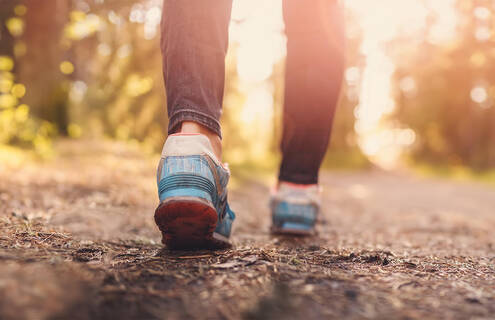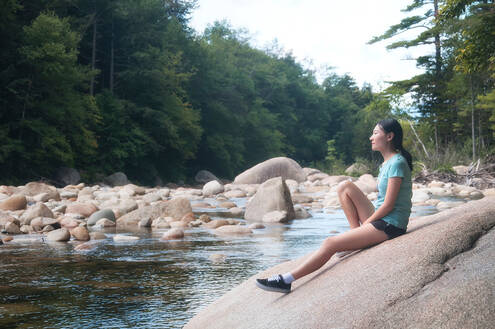
Recreational slip-ons are very comfortable, but they aren't very supportive when it comes to outside activities.
Physical Therapist Kirsten F. GleesonYour feet are full of bones, joints, muscles and nerves. But you probably aren't paying as much attention to them as you should, especially when it comes to footwear.
"The feet are a relatively small area on our bodies we tend to take for granted," says Physical Therapist Kirsten F. Gleeson of Dartmouth Hitchcock Medical Center (DHMC).
Each foot contains 26 bones, 33 joints, 19 muscles and tendons, over 100 ligaments, and more than 7,000 nerve endings in each of the soles.
Poor shoe fit can lead to problems like ankle sprains, blisters, Achilles tendonitis and other foot issues.
While hiking, running or walking this summer, wearing the proper footwear is the best way to support your feet. Our experts share why the shoes you choose can make all the difference.
Subscribe to the Living Better newsletter
Your trusted resource for reliable and up-to-date health and wellness information in the Northeast. Get it delivered to your inbox every other week.
What to look for in hiking and running shoes
Whether you plan to be on mountain trails or paved sidewalks, you should consider terrain, support and grip when buying shoes.
Hiking
Hiking requires more ankle support and room for your toes than sneakers. Look for boots to support your ankles for navigating uneven, rocky or steep terrain.
When choosing the right hiking footwear:
- Choose heavier, sturdier options that offer ankle support and protection from falling branches or thick brush for rugged terrain and lighter boots for flat, even terrain
- Look for footwear with deep traction to help your feet grip surfaces
- Invest in waterproof boots with breathable membranes to keep you dry and comfortable if you plan to hike in wet conditions or cross streams.
Running
Your feet expand and swell when you run, so wearing shoes that are too short or narrow can result in blisters, discomfort and lost toenails. A snug fit around the heel will also prevent your shoe from sliding up and down while you run.
“Running is a high-impact activity, and about two to three times of your body weight goes through your feet with each step,” says Gleeson, who specializes in customized orthotics. “That’s a lot of vertical force."
When choosing the right running shoes:
- Look for at least a thumb’s width of space between your longest toe and the end of your shoe
- Make sure the shoe is comfortable (if it isn’t when you try it on for the first time, it probably won’t feel better when you run)
- Choose a trail running shoe if you go on trails or in fields, which offer better grip, traction and ankle support with deeper tread and rugged outsoles.
When to replace footwear
- Worn-out shoes, even high-quality ones, lose structural support over time.
- Fading tread isn't always a telltale sign of wear and tear. Inspect the sides of your shoes for uneven wear. Look at the foam directly between the sole of your footwear and the rest of the shoe—known as the midsole.
- The midsole will develop compression wrinkles in the foam, a sign the shoe can no longer absorb the loading forces of your body weight.
What about flip-flops and sandals?
Popular summer footwear like flip-flops and flat sandals are fun to wear in the warmer weather. But these shoes provide minimal support and increase your risk for foot issues like heel pain, ankle pain or bunions.
Sportier sandals with contoured soles and straps can be better for short walks but are not ideal for long walks or hikes. You may also feel tempted to wear recreational slip-on sneakers for outdoor adventures.
Don’t do it, Gleeson says.
“Recreational slip-ons are very comfortable, but they aren't very supportive when it comes to outside activities,” she says.
Cushioning in shoes is another big selling point, but plushiness doesn’t equal support.
“The higher your feet are off the ground, and the softer the midsole is under your foot, the greater the chance of stability and balance issues,” says Podiatrist Serena R. Shomody, DPM, FACFAS, of Dartmouth Health’s Cheshire Medical Center. “If you feel wobbly and not firmly planted in a shoe or boot because they're too soft, try something firmer and more stable.”
The size of your feet changes
Your feet spread with age—rather than grow in length—and can affect how a shoe fits.
Ligaments and tendons in your body lose strength and elasticity over time, decreasing your foot arch and causing it to flatten and widen. Ultimately, aging can change your shoe size, so you should measure your feet the next time you buy shoes.
Pregnancy, hormonal changes and genetics can also change your shoe size.
“Even though we don't have strong evidence on this, I think childbirth definitely impacts our feet,” Gleeson says. “It puts weight through our bodies and changes our hips, pelvic areas and how we move.”
Getting professionally fitted with a Brannock device—the standard foot measuring tool you see in shoe stores—is recommended.
“It’s so important to get outdoors and move your body,” Gleeson says. “Just remember to look after your feet and make sure your shoes fit.”


